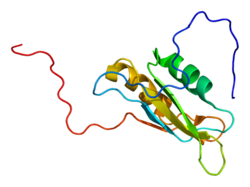| CELF2 |
|---|
 |
| Available structures |
|---|
| PDB | Ortholog search: PDBe RCSB |
|---|
| List of PDB id codes |
|---|
2MY7, 2MY8, 4LJM, 4LMZ, 4TLQ |
|
|
| Identifiers |
|---|
| Aliases | CELF2, BRUNOL3, CUGBP2, ETR-3, ETR3, NAPOR, CELF-2, CUG-BP2, CUGBP, Elav-like family member 2, CUGBP Elav-like family member 2, DEE97 |
|---|
| External IDs | OMIM: 602538; MGI: 1338822; HomoloGene: 4783; GeneCards: CELF2; OMA:CELF2 - orthologs |
|---|
| Gene location (Human) |
|---|
 | | Chr. | Chromosome 10 (human)[1] |
|---|
| | Band | 10p14 | Start | 10,798,397 bp[1] |
|---|
| End | 11,336,675 bp[1] |
|---|
|
| Gene location (Mouse) |
|---|
 | | Chr. | Chromosome 2 (mouse)[2] |
|---|
| | Band | 2|2 A1 | Start | 6,539,694 bp[2] |
|---|
| End | 7,509,563 bp[2] |
|---|
|
| RNA expression pattern |
|---|
| Bgee | | Human | Mouse (ortholog) |
|---|
| Top expressed in | - Region I of hippocampus proper
- orbitofrontal cortex
- entorhinal cortex
- trabecular bone
- middle temporal gyrus
- postcentral gyrus
- Brodmann area 46
- lateral nuclear group of thalamus
- Brodmann area 23
- germinal epithelium
|
| | Top expressed in | - Rostral migratory stream
- lateral septal nucleus
- olfactory tubercle
- nucleus accumbens
- anterior amygdaloid area
- subiculum
- barrel cortex
- ganglionic eminence
- olfactory bulb
- medial dorsal nucleus
|
| | More reference expression data |
|
|---|
| BioGPS | 

 | | More reference expression data |
|
|---|
|
| Gene ontology |
|---|
| Molecular function | - nucleic acid binding
- RNA binding
- pre-mRNA binding
- mRNA binding
| | Cellular component | - cytoplasm
- nucleus
- ribonucleoprotein complex
| | Biological process | - mRNA processing
- RNA processing
- regulation of heart contraction
- mRNA splice site selection
- regulation of alternative mRNA splicing, via spliceosome
| | Sources:Amigo / QuickGO |
|
| Orthologs |
|---|
| Species | Human | Mouse |
|---|
| Entrez | | |
|---|
| Ensembl | | |
|---|
| UniProt | | |
|---|
| RefSeq (mRNA) | NM_001025076
NM_001025077
NM_001083591
NM_006561
NM_001326317
|
|---|
NM_001326318
NM_001326319
NM_001326320
NM_001326321
NM_001326323
NM_001326324
NM_001326325
NM_001326326
NM_001326327
NM_001326328
NM_001326329
NM_001326330
NM_001326331
NM_001326332
NM_001326333
NM_001326334
NM_001326335
NM_001326336
NM_001326337
NM_001326338
NM_001326339
NM_001326340
NM_001326341
NM_001326342
NM_001326343
NM_001326344
NM_001326345
NM_001326346
NM_001326347
NM_001326348
NM_001326349
NM_001394502
NM_001394513
NM_001394517
NM_001394518
NM_001394519 |
| NM_001110228
NM_001110229
NM_001110230
NM_001110231
NM_001110232
|
|---|
NM_001160292
NM_001160293
NM_010160
NM_183219
NM_001310447
NM_001347094 |
|
|---|
| RefSeq (protein) | NP_001020247
NP_001020248
NP_001077060
NP_001313246
NP_001313247
|
|---|
NP_001313248
NP_001313249
NP_001313250
NP_001313252
NP_001313253
NP_001313254
NP_001313255
NP_001313256
NP_001313257
NP_001313258
NP_001313259
NP_001313260
NP_001313261
NP_001313262
NP_001313263
NP_001313264
NP_001313265
NP_001313266
NP_001313267
NP_001313268
NP_001313269
NP_001313270
NP_001313271
NP_001313272
NP_001313273
NP_001313274
NP_001313275
NP_001313276
NP_001313277
NP_001313278
NP_006552 |
| NP_001103698
NP_001103699
NP_001103700
NP_001103701
NP_001103702
|
|---|
NP_001153764
NP_001153765
NP_001297376
NP_001334023
NP_034290
NP_001393762
NP_001393763
NP_001393764
NP_001393770
NP_001393771
NP_001393772
NP_001393773
NP_001393774
NP_001393775
NP_001393776
NP_001393777
NP_001393778
NP_001393779
NP_001393780
NP_001393781
NP_001393783
NP_001393784
NP_001393787
NP_001393846
NP_001393847
NP_001393848
NP_001393849
NP_001393850
NP_001393851
NP_001393852
NP_001393853
NP_001393854
NP_001393855
NP_001393856
NP_001393857
NP_001393858
NP_001393859
NP_001393860
NP_001393861
NP_001393862
NP_001393863
NP_001393871
NP_001393872
NP_001393873
NP_001393874
NP_001393875
NP_001393876
NP_001393877
NP_001393878
NP_001393879
NP_001393880
NP_001393881
NP_001393882
NP_001393883
NP_001393884
NP_001393885
NP_001393886
NP_001393887
NP_001393888
NP_001393889
NP_001393890
NP_001393891
NP_001393892
NP_001393893
NP_001393894
NP_001393895
NP_001393896
NP_001393897
NP_001393898
NP_001393899
NP_001393900
NP_001393901
NP_001393902
NP_001393903
NP_001393904
NP_001393905
NP_001393906
NP_001393907
NP_001393908
NP_001393909
NP_001393910
NP_001393911 |
|
|---|
| Location (UCSC) | Chr 10: 10.8 – 11.34 Mb | Chr 2: 6.54 – 7.51 Mb |
|---|
| PubMed search | [3] | [4] |
|---|
|
| Wikidata |
| View/Edit Human | View/Edit Mouse |
|

 2cpz: solution structure of RNA binding domain 3 in CUG triplet repeat RNA-binding protein 1
2cpz: solution structure of RNA binding domain 3 in CUG triplet repeat RNA-binding protein 1






















